The Effect of Fasting Ramadhan Dietary Management Program on Dietary
Behavior among Diabetic Patients in PKU Muhammadiyah Yogyakarta
Yanuar Primanda, S.Kep., Ns., MNS1 & Ari Budiati Sri Hidayati, S.Kep., Ns2 1
Lecturer at School of Nursing, Faculty of Medicine and Health Sciences, Universitas Muhammadiyah Yogyakarta
2
Lecturer at School of Nursing, Faculty of Medicine and Health Sciences, Universitas Muhammadiyah Yogyakarta & Nurse in PKU Muhammadiyah Yogyakarta
Corresponding Author: Yanuar Primanda, S.Kep., Ns., MNS Email: andromeda_prim@yahoo.com
Mobile Phone: +62 878 383 05050
ABSTRACT
Fasting Ramadhan is one of religious obligation for every adult Moslems in the world. The changes of dietary pattern, sleep, rest, and physical activity during Ramadhan influence the dia eti ’s lood glu ose le el. Edu atio progra to e ha e the a ility of the patie ts to manage their dietary behavior during Ramadhan is critical.
This was quasy experimental study with one group using pre-and post test to examine the effect of fasting Ramadhan dietary management program on dietary behavior among diabetic patients in outpatient department of PKU Muhammadiyah Yogyakarta. Twenty three type 2 DM patients received educational program and educational booklet participated in this study through accidental sampling. The data were collected by using questionnaires that were developed by the researcher. Wilcoxon Signed Rank Test was used to analyze the data.
The result of the study showed that most of the respondents were female with average age 65,5 years old and duration of DM 5,4 years. There was a significant dietary behaviors before and after the intervention (M = 24,5, SD = 1,5, p < 0.05). In conclusion, fasting Ramadhan dietary management program was effective to improve the dietary behaviors during Ramadhan. Diabetic patients have to check their blood glucose, learn about complication and its management during fasting Ramadhan. Further research encompassing more respondents is needed.
Keyword: Fasting, dietary behavior, diabetes mellitus
INTRODUCTION
and one of the ten highest causes of death in hospital. In accordance with its high number, the risk for development of complication is increasing.
Dietary management is one of important aspect of diabetes management. Dietary management is benefit to control blood glucose within the normal range, thus it can prevent and/or delay the development of DM complication (PERKENI, 2011). Although dietary management is important, it is considered as the most difficult management compared to other DM management such as exercise and pharmacological management (Soegondo, 2007). Moreover, during the Ramadhan month, DM patients have to manage their diet to prevent the complication such as hypoglycemia and hyperglycemia.
Among adult Moslems, fasting Ramadhan is one of obligation that have to be done. It is stated clearly in Al Baqoroh 183 where all Moslems must fasting Ramadhan. However, those who are sick, pregnant and breast feed mother, on journey, and very old are allowed not to fasting Ramadhan (Majelis Tarjih, PP Muhammadiyah, 2011).
Fasting Ramadhan means that someone stop to eat and drink since the sunrise until the sundown for one month. Thus, diabetic could not eat, drink, and take medicine during the day time. Although it seem difficult, most of diabetic patients still fasting Ramadhan because they believe that Ramadhan month is blessed month and is benefit for their health. Previous study from Khaled dan Belbraouet (2009) showed that among 276 diabetic obese women patients who were fasting Ramadhan, the body weight and calorie consumption was decreased although the consumption of high fat and cholesterol were increased.
Usually, diabetic patients separate their calorie needs into 3 times meal and 3 times snack. During fasting, the blood glucose is controlled through sahur and glycogen deposit in the heart. However, since the diabetic patients are not allowed to eat and drink at the day time, they tend to consume more food and more calories when they break their fasting (Wijayakusuma, 2009). Uncontrolled DM are at the high risk for complication when they fasting Ramadhan.
Good dietary management for diabetic patients is the key success to prevent complications of the fasting Ramadhan itself. So, they can prevent the development of complication such as dehydration, hypoglycemia, and hyperglycemia. Dietary counseling, education, monitoring blood glucose, adjustment of dose and all of for oral hypoglycemic agent are the important aspect to be concerned, so they can fasting Ramadhan without any problems.
METHOD
Fasting Ramadhan in last period of Ramadhan, 3) Be able to write and read, and (4) Willing to participate in this study.
The patients, who were selected, received fasting Ramadhan dietary management program and educational booklet from the research assistants. This program was educational program with individual education which open the opportunity to discuss any patie t’s pro le s related to his/her dietary eha iors duri g the Ra adha o th. Pre test was done before the intervention and post test was done one month after the intervention. Pre test data measured the dietary behaviors during the last period of Ramadhan month, whereas the post test data measured the dietary behaviors during the current Ramadhan month after the respondents received fasting Ramadhan dietary management program.
The research assistants in this study were three nurses who received training and detail explanation about dietary management program during fasting Ramadhan. The research assistant provided education to the patients during their waiting time in outpatients department of PKU Muhammadiyah Yogyakarta. The duration of each program ranged from 30 – i utes depe d o the patie t’s need.
The data were collected by using questionnaires that were developed by the researcher. The normality data by Saphiro Wilk test showed that the data was not normally distributed (p < 0,05). Therefore, the Wilcoxon Signed Rank Test was used to analyze the respondents, 18 (78%) never received explanation and education program related to dietary behaviors but not specific for dietary management during fasting Ramadhan.
Characteristic Frequency Percentage (%)
Senior high school 6 26
Bachelor 1 4
Work status
Work 6 26
Not work 17 74
Monthly income
< 1 million 11 48
1 million – 2 million 8 36
2 million – 3 million 4 17
Dietary educational program experiences
Never 18 78
Yes 5 22
Insulin therapy
Yes 2 9
Never 21 91
Characteristic Mean SD Min Max
Age 65,5 9,9 43 80
Duration of DM 5,4 4,4 1 15
Before the data was analyzed to examine the effect of fasting Ramadhan dietary management program on dietary behavior among diabetic patients in outpatient department of PKU Muhammadiyah Yogyakarta, the normality data was tested by using Saphiro Wilk. The data was not normally distributed (p < 0,05). Therefore, the Wilcoxon Signed Rank Test with significant value p < 0,05 was used to analyze the data. Table 2 showed the comparation of dietary behaviors average score before and after the intervention.
Table 2. The Comparation of Dietary Behaviors Average Score Before and After the Intervention (N=23)
Dietary Behaviors Mean SD Z score P value
Pre test 17,9 2,6 -4,206 0,00*
Post test 24,2 1,5
*p < 0,05
Table 2 showed that there was a significant different between the dietary behaviors during fasting Ramadhan before and after the intervention (p < 0,05)
In this study, the average age of the respondents was 65,5 years (ranged from 43 to 80 years old). American Diabetes Association (ADA, 2014) stated that age is one of risk factor of DM. Increasing age causes decreasing of body function including the ability of pancreas to secreting insulin in order to keep the blood glucose level within the normal range.
Most of the respondents in this study were female. There is no difference in the risk factor of DM between male and female. Both male and female has similar risk to develop DM (ADA, 2014). The high number of female patients in this study due to the higher number of female patients compared to male patients in outpatient department in PKU Muhammadiyah Yogyakarta.
The average duration of DM in this study was 5,4 years (ranged from 1 to 15 years). The duration of DM was measured based on the first time the patient was diagnosed with DM by the physician. The result of this study is supported by previous study which showed that the duration of DM in Yogyakarta was ranged around 7 years or less than 10 years (Purba, Rahayu, & Sinorita, 2010).
Most of respondents in this study did not receive insulin therapy. PERKENI (2011) stated that diabetic type 2 patients might receive insulin if the patient could not control their blood glucose level with lifestyle modification and oral hypoglycemic agents.
Based on table 2, there was significant improvement on dietary behaviors during fasting Ramadhan before and after the intervention (p < 0,05). This positive outcome could be influenced by several factors such as the characteristic of the program and the media which was used in this study.
This fasting Ramadhan dietary management program was conducted individually. Throughout the process of program, each patient received individual educational session that encompassing discussion and two way communication between the patient and the educator. All of the respondent in this study received at least similar educational content, however they had an opportunity to discuss their personal problem and gain more knowledge and problem solving through individual and two way discussion with the educator. Nagelkerk et al. (2005) stated that individual educational program resulted in better outcome and it facilitated the patient to make better modification on his/her dietary behavior. This is because dietary behavior is influenced by personal, social, and cultural factors (Sumiyoshi, Kawata, Shikata, dan Makino, 2010).
knowledge have better dietary behavior compared to those with poor knowledge (Persell et al., 2004).
CONCLUSION
In conclusion, fasting Ramadhan dietary management program was effective to improve the dietary behavior of the patients with type 2 DM in outpatients department. Nursing should assess the patie t’s dietary eha iors duri g fasti g Ra adha a d pro ide the i for atio ased o the patie t’s eed a ordi g to i di idual k o ledge a d behaviors. This assessment and education will benefit for diabetic patients who is fasting Ramadhan to prevent the possible complication such as hypoglycemia and hyperglycemia. Further research that is encompassing more participants is needed.
REFERENCE
American Diabetes Association (ADA). 2010. Recommendations for management of diabetes during Ramadhan. Diabetes Care, 33(8), 1895-1902
PP Muhammadiyah. (2011). Hipunan Putusan Tarjih Muhammadiyah. Yogyakarta: Grama Surya.
Khaled, B. M., & Belbraouet, S. 2009. Effect of Ramadan fasting on anthropometric parameters and food consumption in 276 type 2 diabetic obese women. International Journal of Diabetes in Developing Countries, 29(2), 62-68
Melchior, L., Carter, B., Helsley, A., Ernest, J. C., & Friesner, D. (2010). The diabetes disease state management exemplar. Nursing Economics, 28 (1), 7-17.
Nagelkerk, J., Reick K., & Meengs, L. (2005). Perceived barriers and effective strategies to diabetes self-management. Journal of Advanced Nursing, 54(2), 151-158).
PERKENI. (2011). Konsensus pengelolaan dan pencegahan diabetes mellitus tipe 2 di
Indonesia 2011 Diakses 15 November 2014, dari: http://www.perkeni.org/.
Persell, S. D., Keating, N. L., Landrum, M. B., Landon, B. E., Ayanian, J. Z, Borbas, C., & Guadagnoli, E. (2004). Relationship of diabetes-specific knowledge to self-management activities, ambulatory preventive care, and metabolic outcomes.
Preventive Medicine, 39, 746-752.
Purba, M. B., Rahayu, E. S., & Sinorita, H. (2010). Dukungan keluarga dan jadwal makan sebelum edukasi berhubungan dengan kepatuhan jadwal makan pasien diabetes mellitus (DM) tipe 2 rawat jalan yang mendapat konseling gizi di RSUD Kota Yogyakarta. Jurnal Gizi Klinik Indonesia, 7(2), 74-79
Sumiyoshi, K., Kawata, C., Shikata, K., & Makino, H. (2010). Influencing factors for dietary behaviors of patients with diabetic nephropathy. Acta Medika Okayama, 64(1), 39-47.
Wijayakusuma, M.H. (2004). Bebas Diabetes Mellitus Ala Hembing. Depok: Puspa Swara

